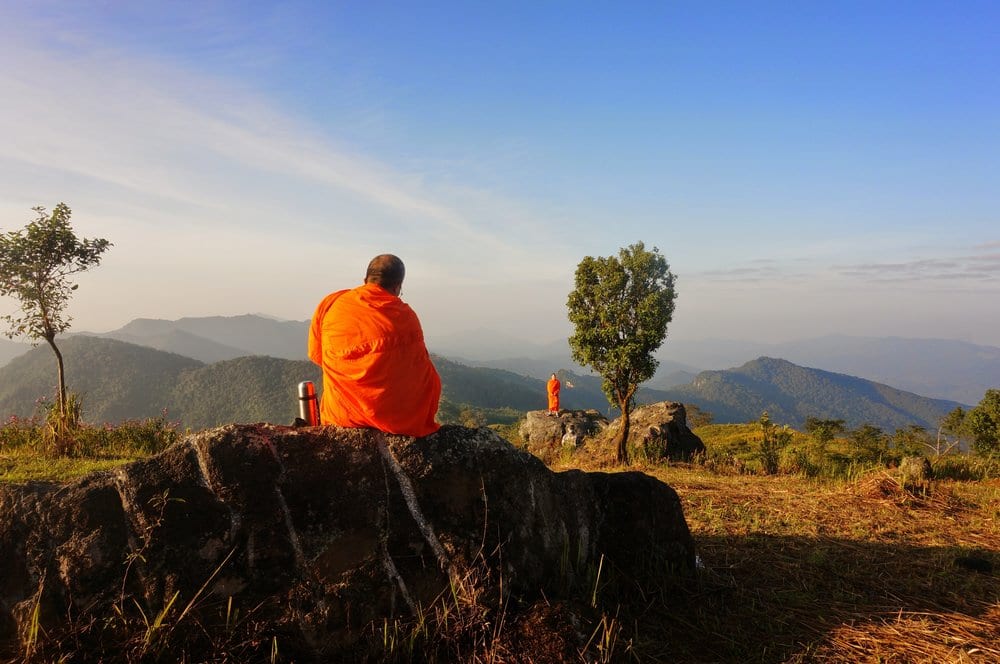Doubting MeditationI used to think that meditation was a thing exclusively for hippies. And by hippies, I mean white people who live on sex communes, wear clothing made of hemp, and greet others with a completely unironic “Namaste” instead of a “hello.”
As a college student at UC Berkeley, I silently made fun of my friends who attended meditation seminars that involved group hand-holding and audible chanting in a field of flowers. In my early 20s, I found myself battling the stress of law school and later, BigLaw life. Yet when others recommended I try meditation to calm my mind, I laughed and replied that it was impossible for me to turn off my mind.
Fast forward to my late 20s, however, and I am now a regular practitioner of meditation. Contrary to what I initially believed, you don’t need to be a white hippie or an Indian yogi to appreciate and enjoy meditation. You don’t even need to be a spiritual person in order to practice meditation. And you can meditate virtually anywhere – sitting on the floor or at your office desk, lying down in your bed, on your morning walk, while washing the dishes, or while drinking a cup of tea.
The more I read about meditation, the more it became impossible to ignore its proven health benefits. For starters, a regular meditation practice can help reduce stress, anxiety, insomnia, and depression, and can even relieve symptoms of pain. And not only does meditation help you live a healthier and happier life, it can literally rewire your brain. A Harvard neuroscientist’s study found that long-term meditators (those who practice meditation for more than 8 weeks) have increased amounts of grey matter in certain parts of their brains. This translates into having enhanced auditory and sensory systems, as well as better memory, cognition, emotional regulation, and decision making, and even greater amounts of empathy and compassion. So if you want to become a better leader, a better spouse, a better friend, a better employee, and a better lover, you should start meditating!
While I have no way of determining whether regular meditation has made my brain bigger and smarter, I can attest to the fact that it has helped reduce my overall stress and anxiety levels. In the past, whenever I would encounter a series of seemingly insurmountable tasks, I would easily get overwhelmed, and I could literally feel the panic coursing through my body. I would mentally tell myself that I would never be able to get all of these (un)necessary tasks done within my artificial, self-imposed deadline, which, in turn, caused me to freak out even more.
These days, I have a much more reasoned approach to stress management. I can’t say that I never succumb to stress because I’m not perfect (though I am certainly close). But I do manage my stress in a healthier way. By eating donuts, obviously. And by taking long deep breaths or listening to a few minutes of the world’s most relaxing song when I experience moments of acute stress. Or, by simply telling myself that whatever needs to get done will eventually get done, and if it doesn’t, life will move on.

Buddhist Meditation Retreat
My first meaningful experience with meditation was attending a 24-hour Buddhist meditation retreat in Chiang Mai, Thailand while I was on a backpacking trip with my partner Max. I had been practicing meditation only in a very informal and irregular manner in the few months leading up to the retreat, so I was nowhere near ready for a 24 hour silent meditation retreat.
In addition to the imposed silence, we were given a uniform of unisex white shirts and white linen pants in an XXXL size, and were prohibited from wearing shoes. This last part irked me the most, as I could literally see the filth collecting on my fellow meditators’ feet.

After learning some of the core principles and teachings of Buddhism and doing a significant amount of chanting, we began our guided meditation. We were taught four different meditation positions: sitting, standing, walking, and lying down.
For sitting meditation, one traditionally sits cross-legged Indian style or in lotus position on the floor, but I must warn you that it is unbelievably hard to sit like this for more than a few minutes, particularly when your lumpy body is accustomed to sitting on a cushiony, ergonomic chair. Instead, I opt for sitting in an upright chair or with my back upright against an array of pillows on a comfy couch when I meditate. I call this meditation for the lazy millennial. Standing meditation involves standing very still while meditating, and walking meditation involves walking extremely slowly, one inch at a time. Lying down is my favorite type of meditation, though I have yet to successfully complete an entire lying down meditation session without falling asleep.
Meditation Basics
At this point, you might be wondering what exactly do I do when I am sitting or lying down. Aside from unsuccessfully fighting the urge to fall asleep, I try to focus on one of two things while I’m meditating: the rise and fall of my breath, or being aware of the sounds, bodily sensations, emotions, and thoughts that are presently passing through my body and mind. These practices are part of the Vipassana style of meditation, the traditional Buddhist meditation practice that focuses on mindfulness and which I learned about at the retreat in Thailand. There are many different types of meditation practice, but I will focus on Vipassana meditation because that’s what I practice. You can learn about other meditation practices here.
Many people are hesitant to embrace meditation because the idea of turning off your brain and thinking about nothing seems impossible. Fortunately, the notion that meditation involves thinking about nothing is just a myth. In fact, meditation entails quite the opposite–it requires you to be fully present in the moment, to check in with your mind and body, and to be completely aware of whatever is happening around you and within you, but in a detached, nonjudgmental way. For instance, if your stomach is growling while you are meditating, become aware of it, and perhaps, silently say to yourself “My stomach is growling.” Do not try to ignore the growling or lament it, or worse yet, get up and go get yourself a snack (ill-advised choice, based on personal experience).
Once you understand that meditation simply involves being aware of your surroundings in a conscious and deliberate way, meditating is a rather simple process. If you are a beginner, sit down in cross-legged position or in a chair, with your back upright. Then, draw your attention to your breath. Try to focus in on one aspect of your breath–either the breath coming out of your nostrils and the sensation of blowing air in and out of your nose holes, or, the rising and falling of your chest or of your stomach. As you try to focus on your breath, your mind will certainly wander to other topics–Why did I say that bitchy thing to my spouse?Should I eat a large pizza or a garden salad for lunch? How do I tell my boss that I think he’s a wanker without getting fired?
Instead of being angry or judgmental with yourself for these roaming thoughts, simply try to notice when you become distracted and then restart the process of focusing on your breath. When I catch my mind wandering, I try to gently bring my mind back to my body and my breath and remind myself that this is “me time.” And during “me time,” there is no time for useless, worrisome thoughts.
So, how should you be breathing when you meditate? There’s no need to engage in exaggerated or stylized breathing. And there are several options to keep track of your breath. For one, you can inhale for two counts (1, 2) and then exhale on counts 3 and 4. You can repeat this process for the remainder of your meditation. Or you can keep counting up towards 100. Alternatively, count to 1 in your mind as you breathe in, and count to 1 again as you breathe out; continue to 10 and repeat the process several times. You will notice that once your mind starts to wander, you will lose count. Don’t feel discouraged, as this happens to nearly everyone.
Meditation Tips
For beginners, the prospect of sitting in silence and listening to nothing but your breath and the creepy sounds emanating from your body might sound terrifying. Not to worry! There are tons of apps you can listen to help you get through your meditation session. Here are a few apps/podcasts that I have tried out in the past and have found to be helpful. You can find even more recommended meditation apps here.
-
Calm: Listen to a basic guided meditation session or simply ambient noises while you meditate, like waves sexily crashing ashore or snowflakes gently falling onto your tongue.
-
Headspace: This app is marketed as a “gym membership for your mind.” Their “Take 10” program is a free 10-day program where you can learn the basics of meditation in just 10 days. Subscribe for additional exercises.
-
Buddhify: Designed for busy people who live big city lives, this app helps you meditate while you’re walking, commuting, exercising, or chillaxing at home.
-
Meditation Made Simple: Proves that meditating and being cool are not mutually exclusive. This app from hip hop and meditation mogul Russell Simmons includes a description of meditation’s benefits, a primer on how to meditate, 10- and 20-minute guided meditation exercises, and a vibration that can help calm your mind during meditation.
-
Brain Wave: not a meditation app, but this app offers dozens of sequences of binaural tones to stimulate brainwave frequencies associated with various states of mind, including meditation, critical thinking, concentration, pre-exercise energy, stress reduction, calm reflection, deep relaxation, yoga meditation, and my favorite, hangover relief.
Of course, a Buddhist monk would tell you that you don’t need any apps or technology to meditate. However, meditation is just like exercising, and sometimes a personal trainer or accountability app can be the difference between building a six-pack and letting your gym membership lapse. Another similarity between meditation and exercising involves timing. Start your meditation practice slowly, with just one minute a day, and gradually work your way up to longer periods of meditation or new styles of meditation.

You can meditate while you’re sunset gazing
My Week of Meditation
I try to meditate every day or nearly every day for relatively short periods of time. My ordinary schedule is to meditate upon waking in the morning for five to ten minutes. Sometimes, I listen to an app, other times I just listen to ambient noise, and some days, I simply sit in silence in order to fully absorb the beauty of my being.
To further challenge myself, I decided to devote 20 full minutes to meditation each day this week. 20 minutes might seem like a lot of time, but I certainly spend more than 20 minutes on entirely useless activities, like reading depressing news headlines involving Donald Trump and taking the umpteenth Buzzfeed Quiz on my GOT persona simply to confirm that I am as cool as Tyrion or as badass as Daenerys Targaryen. As Russell Simmons says, “If you don’t have 20 minutes to delve into your self through meditation, then that means you really need two hours.” Afraid that I would be forced to meditate for two hours a day, I told myself that I certainly had 20 minutes to devote to meditation each day.
Typically, I meditate in the morning, but I didn’t want to feel rushed through my morning routine, so I scheduled my meditation for 10 p.m. before bedtime on Monday through Thursday. Not entirely surprising, but I fell asleep each night before the 20 minute mark was up. The silver lining to my failure was that I was able to fall asleep almost instantly instead of spending my usual 15-30 minutes drifting to sleep.
On Friday, I was heading down to Miami for my friend Carly’s bachelorette party, so I scheduled my meditation for the morning. While I didn’t fall asleep, I did notice that my mind was racing more than usual, as I kept thinking about whether I had packed enough crop tops and snacks for the weekend. On Saturday, after lounging on the beach for six hours, I headed back to the hotel room a bit earlier than everyone else so that I could meditate in peace. Unfortunately, spending the day in the sunshine made me sleepy, and I fell asleep yet again before the 20 minute mark was over. On Sunday, I attempted to meditate on the flight home, but the relentless screaming of a teething toddler and my fear of airplane turbulence made me jittery and unable to concentrate on anything aside from the constant screaming and shaking.
So, what did my week of meditation teach me? First, do what works for you. Ideally, I would like to devote 20-30 minutes a day to meditation. But, if that doesn’t work with my schedule every day, I’m not going to dwell on it and let it ruin my meditation practice altogether. Meditating for even five minutes a day is better than nothing, particularly when I can notice an improvement in my stress level and mood during periods of regular meditation. Second, don’t practice lying down meditation unless you have an uncanny ability to not fall asleep. Third, the more you try meditation, the better you will get at it. Maybe I wasn’t able to successfully meditate on a turbulent airplane this weekend, but that doesn’t mean I won’t be able to accomplish that next year. Because, next year, I will definitely be packing a Xanax in my carryon bag.
Are you an avid meditator? Or curious to learn more? Drop me a line! Next week I’ll be focusing on channeling my creativity by writing down 10 new business ideas every day.
Hearts,
Nisha




I loved all your meditation tips. I stumbled upon your website for the first time today and I have enjoyed getting to know your story and your delicious recipes. I can’t wait to try them out for my family to try.
Thanks for the lovely feedback, Michelle! We hope you enjoy the recipes :)
Thanks. This article has inspired me to be more consistent with my meditation.
Happy New Year
We are so happy to hear that, Carole! Enjoy your 2022!